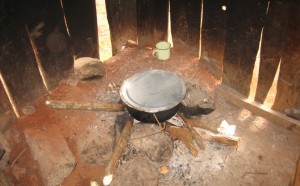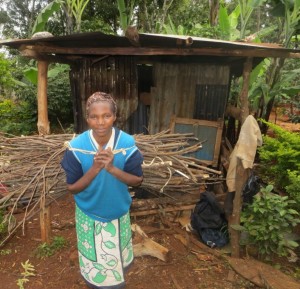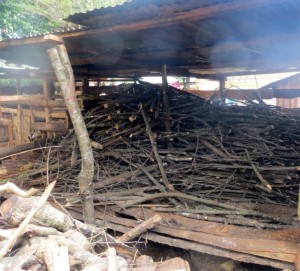
By Susan Onyango, originally posted at ICRAF’s Agroforestry World Blog
According to the International Energy Agency (IEA), about 2.5 billion people in the world, mostly in developing countries, depend on biomass energy for cooking and heating. In sub-Saharan Africa alone, over 90% of the population rely on wood fuel, particularly charcoal and firewood, for their cooking energy needs. Firewood for domestic use is collected from both on-farm and off-farm sources.
The commonly used traditional open-fire three-stone cook stoves consume large amounts of firewood and create indoor air pollution. Smoke in the kitchen is a major concern to those that lack access to clean cooking facilities. According to the World Health Organization, over 4 million people die annually from illnesses attributable to indoor pollution from cooking with solid fuels such as firewood and charcoal. Children and women are particularly vulnerable to this silent killer.
Cecily Muthoni is smallholder farmer in Embu, on the slopes of Mount Kenya about 120 kilometres north east of the country’s capital, Nairobi. On her one-acre farm, she grows cassava, beans, maize, Irish potatoes and a range of vegetables for subsistence, alongside tea, coffee and macadamia nuts as cash crops. She also grows sugarcane, mangoes, avocados and bananas for sale and home consumption.
Muthoni has about 170 exotic and indigenous trees on her farm. She has two cows, two goats and a few poultry. Like other women in her community, she uses both a charcoal stove and the three-stone cook stove to prepare meals for her family of five. Virtually all households in Embu use firewood on three-stone cook stoves, with over 70% of the population sourcing it from trees on their own farms.

She would have possibly stretched this if she used an energy efficient cook stove. When her stocks are low, she purchases firewood from her neighbours at Ksh. 100 (about USD 1) per lot of 34 kilogrammes. The same quantity of firewood costs over Kshs. 200 (about USD 2) from other sources.
Prunings from trees found on farms are a readily available and affordable source of energy for cooking. What households like Muthoni’s need are efficient cook stoves that use less wood fuel and with less smoke than conventional cook stoves.
Options for cleaner cooking solutions
A recent study by a team of scientists compared the ease of use, fuel use efficiency and gas and particle emissions of a small-scale gasifier cook stove with that of the traditional three-stone stove.
Gasifier stoves use biomass and burn fuel at low oxygen levels to produce gas that ignites at high temperatures of about 7000C resulting to reduced emissions of carbon monoxide, carbon dioxide and fine particulate matter. The stoves burn on firewood and crop residues such as coconut shells and husks, and maize cobs. These are converted into charcoal as a by-product and can also be used for additional cooking, or as biochar to improve the retention of nutrients and water in soil. The traditional three-stone cook stove uses larger pieces of firewood and produces a lot of smoke particularly if the wood is not properly dried.

The cooking test
The study involved cooking experiments in which five households were randomly selected to participate. The trials compared the effect of using Grevillea prunings, against maize cobs and coconut husks as types of fuel on the gasifier stove. Five-person meals were cooked between 3p.m. and 6 p.m., with five tests carried out in each household.
“We found that compared with traditional three-stone cook stoves, the gasifier cook stove saves 27 to 40% of fuel, reduce cooking time by 19 to 23% and reduced emissions by 40 to 90%,” said Mary Njenga, lead researcher for the study and scientist at the World Agroforestry Centre.
The women felt that adopting the gasifier would help cook food faster and save the amount of firewood they needed, freeing time for other activities and reducing the burden on collecting firewood. They also pointed out that the gasifier uses smaller pieces of firewood than other types of stoves, making tree pruning a good source of cooking fuel. For some, the need to cut firewood into small pieces to fit into the canister was a bit cumbersome as it required additional labour. The coconut shells and maize cobs did not require any prior preparation.
The Grevillea prunings cooked food faster than the maize cob and coconut shells while the maize cobs produced more smoke than the Grevillea prunings and the coconut shells.
“I found the gasifier stove good to cook with. It will help me cook faster and save the amount of firewood I need. This will give me more time to do other activities and reduce the burden of searching for firewood,” said Muthoni. “However, this stove does not produce as much warmth in the kitchen as the traditional three-stone cook stove does. We often sit in the kitchen during the cold season to warm ourselves.”
Benefits of the gasifier cook stove
There is an opportunity for extending use of the gasifier to address energy poverty and health risks associated with domestic biomass energy in developing countries. Use of prunings from trees on farms and reduced consumption of charcoal and firewood will save trees and encourage forest regeneration. In the long-term, this will contribute to climate change mitigation. Charcoal is a by-product of the biomass burned in the gasifier stove and can be used as fuel for use on other cook stoves.
The researchers recommend improvements to respond to women’s cooking practices to encourage the use of the gasifier stove. It is noted that a household’s commitment to saving fuel, reducing smoke in the kitchen and lessening labour for firewood collection are major considerations for the adoption of the gasifier cook stove
“The gasifier cook stove saves fuel and income spent on energy for cooking. It also produces charcoal for further cooking, for sale or use for improving the retention of nutrients and water in soil, cooks relatively fast and reduces indoor air pollution from cooking with biomass. There is need for further work to understand peoples’ cooking culture using wood fuel and other biomass and how it fits into cleaner cooking solutions for increased demand and adoption,” concluded Njenga.











